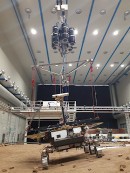Now that the Perseverance rover is safely on Mars doing science, the eyes of the world are turning toward the next high-profile mission humanity will be sending to the Red Planet. It’s called ExoMars, and it will depart in late 2022.
For a while now, the main agencies behind the mission, ESA and Roscomos, have been trying to get the recipe right for the parachute system that will land the Kazachok surface platform and the Rosalind Franklin rover on the surface of the planet.
Parachutes are essential in slowing the descending hardware down and bringing it safely to its designated landing spot. Throughout 2019 and 2020, ESA has been testing the parachutes with mixed results.
Just as planned, at the beginning of June, the first high-altitude drop test with a mock capsule and the mission’s parachutes was performed as a means to see whether all the tweaks made so far worked. And they (kind of) did.
The mission requires two parachutes. The first stage is a 15-meter (49-ft) piece that will open while the lander is still moving at supersonic speeds. The second stage is much larger, at 35 meters (114 feet), and it is the one that will bring the lander down to the surface.
During this week’s test, which took place at the Swedish Space Corporation's Esrange facility, a dummy capsule was taken to an altitude of 29 km (18 miles) via a stratospheric helium balloon and then released.
The first stage “performed flawlessly at supersonic speeds,” according to ESA, while the second stage came out at the other end with some undisclosed damage, but not enough to prevent it from bringing the capsule down safely as expected.
Like all other missions to Mars so far, ExoMars will be tasked with looking for signs of life. It will depart on a Proton-M rocket from Baikonur, Kazakhstan, and land in the Oxia Planum region of Mars in June 2023. Enough time for ESA to get all things right.
Parachutes are essential in slowing the descending hardware down and bringing it safely to its designated landing spot. Throughout 2019 and 2020, ESA has been testing the parachutes with mixed results.
Just as planned, at the beginning of June, the first high-altitude drop test with a mock capsule and the mission’s parachutes was performed as a means to see whether all the tweaks made so far worked. And they (kind of) did.
The mission requires two parachutes. The first stage is a 15-meter (49-ft) piece that will open while the lander is still moving at supersonic speeds. The second stage is much larger, at 35 meters (114 feet), and it is the one that will bring the lander down to the surface.
During this week’s test, which took place at the Swedish Space Corporation's Esrange facility, a dummy capsule was taken to an altitude of 29 km (18 miles) via a stratospheric helium balloon and then released.
The first stage “performed flawlessly at supersonic speeds,” according to ESA, while the second stage came out at the other end with some undisclosed damage, but not enough to prevent it from bringing the capsule down safely as expected.
Like all other missions to Mars so far, ExoMars will be tasked with looking for signs of life. It will depart on a Proton-M rocket from Baikonur, Kazakhstan, and land in the Oxia Planum region of Mars in June 2023. Enough time for ESA to get all things right.










